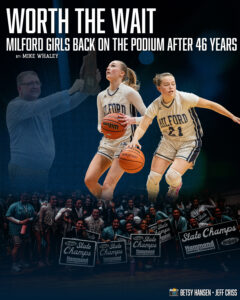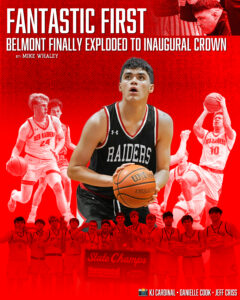By Mike Whaley
(This is the fifth in a series on the 2025 NHIAA state championship basketball teams.)
 When Mike Davidson took over as head coach of the Milford High School girls varsity basketball team in 2019, there was very little in the way of recent success. In fact, the Spartans were nearly 40 years removed from their glory days in the 1970s. Back then, Milford was a power, winning three state titles in four years, including back-to-back Class I championships in 1978 and 1979. But that, as they say, was years ago.
When Mike Davidson took over as head coach of the Milford High School girls varsity basketball team in 2019, there was very little in the way of recent success. In fact, the Spartans were nearly 40 years removed from their glory days in the 1970s. Back then, Milford was a power, winning three state titles in four years, including back-to-back Class I championships in 1978 and 1979. But that, as they say, was years ago.
When Davidson was hired after 16 years coaching in neighboring Massachusetts, the three previous Milford seasons weren’t good: 5-13, 3-15, 3-15. After he took the job, Davidson got the full skinny on the state of the program from then athletic director Marc Maurais. “There were some decent kids and a good freshman class,” Davidson recalled being told. “There were some seniors, but they were probably not going to play basketball anymore. That’s because it was a really losing team for a long time.”
Although there was the potential for a brighter future, Davidson’s first two seasons were difficult. The Spartans played 34 games and lost all of them. “The girls who were there worked hard,” he said. “There wasn’t a ton of talent.”
All that changed in 2021 with the arrival of a promising group of freshmen – Avery Fuller, Claire Cote, Ellie Nassy and Lulu Maguire. Four years later, that now senior core, coupled with junior point guard Shea Hansen and sophomore guard Lexi Bausha, led Milford to the Division II summit – a 43-36 win over Oyster River in the D-II championship at the University of New Hampshire. The long wait was finally over.
Davidson singles out Shea’s older sister, Kate Hansen, and Bailey Johnson as the ones who helped turn the program around when the freshmen came in in 2021. They had weathered the two winless seasons. “They got the ball rolling,” he said. “They could have given up on basketball, but they didn’t. They stayed with it.”
Led by the elder Hansen and Johnson, the Spartans made the 2022 D-II playoffs with a 9-9 record, losing in the first round at No. 5 Laconia, 61-35.
The following year, Milford really broke out. They went 14-4 to earn the No. 6 seed in the playoffs. In the first round they handled No. 11 Derryfield, 42-27, before getting routed in the quarterfinals by No. 3 Pelham. It was still a big step in the right direction.
“We started to get to know each other and bond,” Fuller said. “We won a little more – the Nashua holiday tournament. We started to spark. We made a name for ourselves that year.”
Shea Hansen came in as a freshman that year and quickly established herself as the Spartans’ point guard. “Shea is everything you need a point guard to be,” Davidson said. “She wants the ball all the time. She never wants to come out of the game. She never turns the ball over.” Hansen had just 39 turnovers in 23 games. She definitely helped the Spartans make the jump to the next level.
Which brings us to last season where Milford saw the potential to move to the top tier of the division. It all came crashing down during the holiday tournament in Nashua. Maguire, the team’s leading scorer, went down with a severe ACL injury and was lost for the season. The Spartans struggled for the rest of the season to recover.
“We were in shock,” said Fuller. “It took us time to adjust. We rotated the lineup almost every single game. It took us a while to click with that group. That’s why our record went downhill.” The Spartans went 8-10, but still made the D-II tournament, but were out in one game, a 61-46 setback at No. 4 John Stark.
“The ACL (injury) really set her back,” said coach Davidson of Maguire’s injury. “That put a screeching halt on anything we were expecting to do that year.”
Maguire’s injury changed the team’s dynamic since she would never be the player she once was. That blow was softened over the summer when assistant coach Dennis Claire, Claire Cote’s grandfather, approached Davidson about picking up a player from Wilton for the summer league team. Davidson figured that you could never have enough players during the summer when the kids had other commitments and weren’t always available. That’s how Lexi Bausha first joined the team, as a summer-league teammate, and eventually as a high school teammate when she transferred to Milford.
“That was a nice early Christmas present,” Davidson said with a chuckle. “She had scored almost 300 points as a freshman at Wilton-Lyndeborough. Having her onboard was a home run. Lulu was still on the shelf. We needed that fifth starter. It was nice to have her there.That’s when it rounded into shape and we became a very competitive team. We had a solid top six. We felt really good about everything.”
Going into the 2024-25 season, everyone was back (once Maguire was able to play) with the addition of Bausha. There was plenty of potential there. Davidson felt good about what he had. In the division, people knew Milford was going to be pretty good. They weren’t going to sneak up on anybody. Even so, with all they had, the Spartans had won just one playoff game in the three previous playoff trips. “Once we had Lulu back in the lineup, we knew we were going to be pretty good,” he said. “I don’t think anybody thought we would do what we did – except us.”
Milford definitely felt it could win the championship. Davidson recalls it being talked about during the preseason. “We had meetings,” he said. “The only thing they wanted to talk about – ‘We’re going for the state title, coach.’”
Fuller remembers the team making that collective preseason prediction. “Our goal at the beginning of this season, we all wanted to win it.”
“I feel like we had two trophies we wanted to get: the Christmas tournament and the state championship,” Hansen said. “Just knowing we could work towards that and it was in the picture, it pushed us to a whole other level.”
Fuller would go on to make D-II First Team All-State and the All-Defensive Team. Davidson said she was really difficult to guard inside and difficult to keep off the boards. At 5-foot-10, her length on defense was a huge asset. “She’s very, very good around the basket.”
As for Fuller’s classmates, Cote was described by Davidson as the player “that does everything that nobody notices – sets the right screen, positions herself correctly for an offensive or defensive rebound. She clears a path so the other kids can get to the rim and score.” He said, she’s on the back of the press watching everything unfold before her and communicating where the ball was. Nassy was a solid scorer, like Cote, whose strength was on defense with her length. She led the team in deflections and was among the leaders in steals. “She just had a real nose for where the ball was going to be,” the coach said. As for Maguire, she was not the player she once was because of the injury, but she could still fill it up, giving the Spartans a respectable long-range shooter on the other side of the court.
The postseason awards also rolled in for Fuller’s teammates. Hansen was named Second Team All-State and received the Jack Ford Award. Nassy was All-State honorable mention.
Now the Spartans needed to deliver. The regular season was a success with Milford going 15-3 in the division and 17-3 overall after capturing the the Nashua holiday tournament with a pair of wins. All three losses were good learning moments. The first was to preseason favorite Laconia at home, 50-35. Milford changed up its defense from zone to man-to-man and it backfired. Fuller felt they were less effective and that Laconia was able to get by them easier.
In late January, Oyster River came to town and Maguire returned 13 months after her injury. Although the Spartans lost by five, 63-58, Maguire showed she could be a factor, hitting a trio of 3-pointers for nine points in limited minutes. Milford’s rotation was now complete.
Milford’s final loss came on Feb. 7 at Bow without Fuller, who had the flu and could not play. They lost by two points, 50-48, but certainly felt had they had Fuller, they would have won the game. They never lost again.
They won their final six games of the regular season, including quality victories over Coe-Brown, Derryfield and Pembroke. The win over Pembroke in the last game by a score of 47-35 bolstered the Spartans’ growing confidence. “That made everybody look at each other in the locker room after the game and say ‘we’re ready,’” Davidson recalled. “‘We can do this now in the playoffs.’” Their 15-3 record earned them the No. 2 seed in the tournament and a bye to the second round.
Davidson knew the quarterfinal game at home with No. 10 Coe-Bown would be difficult. They’re a team that is hard to shake. “You have an 11- or 13-point lead and then you look up in the fourth quarter and they’re back within four points,” he said. “They’re one of those teams. Fortunately, we had a nice little run in the fourth quarter that put our stamp on the game.” The final score was 55-42 with Hansen leading a well-balanced attack with 14 points. Fuller added 12, while Cote and Maguire had nine apiece.
There was definitely a playoff-type atmosphere in the Milford gym, an unusual occurrence in recent years. “We had the home crowd behind us,” Davidson said. “There were a ton of students. It really energized the team.”
Milford now found itself in recently uncharted territory in the D-II semis at Pinkerton Academy. They were one win away from returning to the championship game, where they had not been since losing in the 1981 Class L final. Their opponent? No. 3 Derryfield.
Davidson knew that the deeper you got into the playoffs, the more defense played a role. “Don’t rely on outscoring them,” he told his team. “You’re going to have to shut them down defensively. It was easily our most remarkable defensive effort of the year.”
Derryfield had no answer for the Milford defense. They generated a little bit of offensive life with some corner 3-pointers, but they could not get to the rim. “They just couldn’t get it inside,” Davidson said. “That’s all due to Avery and Ellie. We just did a great job of not allowing them to get it inside. That made the difference.” The Spartans pulled out a 37-29 win to head for the championship at UNH. Cote led the offense with 11 points, while Bausha added eight and Fuller had seven.
Defense definitely made Milford go. They played a combination halfcourt and fullcourt zones that constantly pressured the opposition. It made it hard to score inside against them, sparked by Fuller and Nassy’s length, which clogged up passing lanes, causing deflections and steals. When that defense was clicking, the Spartans could then kick their effective transition game into gear.
No. 4 Oyster River upset No. 1 Laconia in the other semifinal, 39-36, to set up the final. Milford knew if it won its semifnal vs. Derryfield that it would be playing a team that had beaten them during the season.
The Bobcats were going to be a difficult opponent. They had set a tournament record with 14 3-pointers as a team in a 66-48 quarterfinal win over No. 5 Pembroke. “We knew we couldn’t let them get comfortable at the 3-point line,” Davidson said. “That’s where they do most of their damage. We put a lot of effort into making sure shooters were uncomfortable.”
Milford was able to hold two of OR’s top long-range shooters down, allowing three 3-pointers between them. Their best 3 shooter, Vivian O’Quinn, made all three, but Davidson figured she needed to sink six to help the Bobcats win. As it was, it still went down to the wire.
In fact, Oyster River came out on fire, hitting a trio of treys in the first several minutes to go up 9-3. “We didn’t expect them to come out that strong,” Fuller said. “They were shooting behind the college line. We didn’t expect them to be shooting that far back. I remember Vivian O’Quinn hitting a basket from the logo that was a real wakeup call for us. We knew we really had to start going out on the shooters.”
Milford regrouped and got back in the game, actually taking an 11-10 lead late in the first frame. They trailed 12-11 after the first quarter and 20-17 at the half.
Davidson said at the half “We always look at the third quarter as our quarter. We feel like if we can come out and be the aggressor and win the quarter then that’s going to set us up for winning the game.” That’s just what the Spartans did. Led by Bausha, who scored 19 of her game-high 21 points in the first three quarters, they surged in the third (14-7) to take the lead for good, 31-27.
The strength of Milford was in its impressive balance. You could not look at its lineup and zone on one or two players who were putting up big numbers. They didn’t have those kinds of scorers. They’re primary six players were tightly grouped together averaging at the low end (Maguire, 7.2 points per game) to 11.9 ppg at the high end with Fuller. There were no big numbers staring anyone in the face. “That was the hallmark of this team,” Davidson said. “If you’re the opposing team and you’re talking in your practices about playing Milford. You’ve got to shut down Avery. You’ve got to shut down Shea Hansen from outside. Somebody else is going to get you. If you looked up and down our games this year, different people came up big throughout the season. It wasn’t one or two kids doing it all. … It just turned out that in that championship game it was Lexi’s turn. She was the one getting all the lanes to the basket. She got fouled a ton. (She made a championship record 8-of-9 foul shots). She just killed it, getting inside and scoring on layups.”
Once Milford got its transition game going, it was just a matter of Hansen finding someone at the end of her passes to get the baskets. That was Bausha. “Once Lexi started running, I could just keep hitting her and obviously she wanted the ball and was ready to put it in the hoop.”
In the fourth quarter, Oyster River cut the lead to three on three occasions, the last time coming with 26 seconds to play on a foul shot by Olivia Andersen, 39-36. The next sequence proved to be a decisive one in the Milford victory. Fuller was fouled at 23 seconds, but missed both foul shots. Nassy, at 5-9, rebounded the second miss, drew her own foul and then made both freebies to ice the win. Fuller added a layup to pad the final tally, 43-36.
“I kind of felt a little pressure on me. If I missed them both then we could have lost the game,” Fuller recalled. “When I missed that (second) foul shot, Ellie grabbed the rebound. I was really happy. I was really happy she got fouled on that and sank both of the foul shots. It was redemption to get those points back.”
Bausha led the Spartans with her season-high 21 points. Fuller added 10 and Hansen tossed in seven. O’Quinn led OR with 13 points.
Milford’s team-first, unselfish approach had been rewarded, ending a 40-plus year championship drought with an overall 20-3 mark. “Nobody for Milford cared who scored the points,” Davidson explained. “They just didn’t care. ‘OK, it’s Lexi’s day today. Fine. I’ll sacrifice my points to keep the ball in Lexi’s hands.’ It was like that all year long. Nobody cared who scored. That’s ultimately from an offensive standpoint what got us over the top. That selfless thing; whoever is open, you score.”
Davidson recalls talking to Maguire after the team banquet, mentioning how sorry he was that she did not score a point in the championship game. Her response epitomized everything about Milford this season. “‘You know, Coach, I knew I wasn’t going to be making any shots in that game early (on),’” he recalled her saying. “‘I’m just going to get it done on defense.’ And if you watch the video on the game, she was really, really good on defense. She made the opposing guards have a hard time. That’s the kind of team we had. ‘I’m not scoring. I’ll do it this way instead.’”
Davidson said having two veteran assistants played a major role in Milford’s success. Cote’s grandfather, Dennis Claire, a coaching legend from nearby Wilton-Lyndeborough, and Joe Bibbo “were really, really important to me,” said Davidson, referring to the nearly 100 years of coaching experience that melded whenever the three were together. “Just talking things through on the way to a game or in the gym in practice,” he said. “‘How are we going to stop this team from doing their thing?’ They were really, really good at helping the team to be a state champion.”
The emotion erupted when the final buzzer sounded. “The first person I hugged was Lulu,” said Fuller, who will attend and play basketball next year at Plymouth State. “I was really proud of her. She went through so much in a year. She had so many ups and downs through her ACL surgery and recovery. I remember both of us had tears in our eyes.”
Davidson was touched by the community support. “I’ve coached a lot in Massachusetts,” he said. “I’ve never seen a community rally around a team the way the Milford community did. When we walked out on that court to warm up at UNH, I was dumbfounded at the number of people that were in the stands on the Milford side.”
It certainly has been quite a journey from Davidson’s first years and the struggles the Spartans had. “Coming from six years ago when parents were dropping off their kids at games and not staying to watch them play and two winless seasons,” he said, “to see the support of an hour and a half away from Milford, it was really special. The way the police and the fire (departments) took us around the oval in Milford after we won. The number of people that were there holding signs and cheering for us, while we were getting the escort, it was really something. It really made it a memorable day.” That was well worth the wait.
Whaley can be reached at whaleym25@gmail.com




